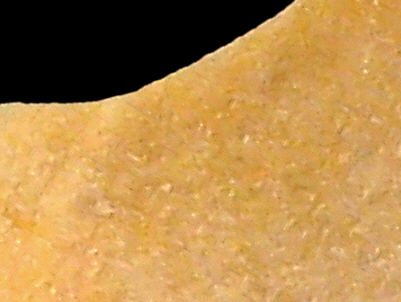
Foto: Jehanne Féblot-Augustins, 2005.
- Breignes-Pierre-Feu 2
Sampled sites:
| Material name: | CN8c |
| Synonyms: | N/A |
| Material (geologic): | Late Cretaceous (Senonian, Campanian) flint |

Foto: Jehanne Féblot-Augustins, 2005. |
Sampled sites:
|
| Mode of occurrence: | A single fist-sized regular nodule. |
| Cortex: | Thin, smooth and worn, transition sharp. |
| Colour: | Brownish yellow (10YR 6.5/6). |
| Pattern: | Featureless. |
| Appearance: | Homogeneous material, dull and opaque, dry, quite rough, medium-grained. |
| Structure: | Distinctly fluidal arrangement of grains. |
| Texture: | Wackestone. |
| Matrix: | Subtranslucent. |
| Grains: | 25 %, pale, rounded with high to low sphericity or irregularly shaped, poorly sorted (mean size 100 µ, foraminifera of 250 µ, long spicules of 1000 µ). |
| Grain composition: | Mainly long monaxon thin-walled sponge spicules, some globose planktonic foraminifera, bryozoan fragments (?). |
| Further information: | Click here for the original French description (opens in a new window), or here for more information on the attributes used in the description (use your browser's "BACK"-button to return here). |
| Citing: | Information on citing this page can be found here. |
| Locality: | Poncin / Breignes - Pierre-Feu 2, France, Ain department |
| Synonyms: | Sampling site Bugey 34 after Féblot-Augustins |
| Geographical description: | The source is located near a narrow road/path on a slight rise between the hamlets of Chenavel and Breignes, a bit over half a kilometre to the west of the latter, and somewhat more than 2 kilometres SSE of Poncin. |
| Geographical co-ordinates: |
east/x 838.2 north/y 2122.9 (Lambert zone II, NTF)
This corresponds with |
| Co-ordinate precision: |
The Lambert-coordinates given were read from a detailed topographical map, and are within 50 metres of the precise location. The latitude/longitude coordinates are a direct transformation of these data on WGS84 and have the same accuracy. They are given to the apparent high accuracy to prevent the introduction of a rounding-error. The location can be found on the 1:25 000 topographical map sheet 3230 W of the French Institut Géographique National. |
| Geology: |
The embedding materials are, according to the geological map, Late Miocene (Tortonian) continental sediments, belonging to the stratigraphic unit m2bC. The reworked flint of the CN8c-type originates from Late Cretaceous (Campanian) limestones. Map of all sampled localities of Late Cretaceous flint in the Bugey (PDF, 54 KB, opens in new window). |
| Type of source: | Secondary. Redeposited Campanian flint from Miocene sediments. |
| Other types of flint: | Apart from the singular CN8c-type, other Late Cretaceous flints of the types CN1a and CN2a can be found here, as well as the Middle Jurassic Bt material and Early Cretaceous Ht1 flint. |
thumb.jpg) Foto: Jehanne Féblot-Augustins, 2005 |
thumb.jpg) Foto: Jehanne Féblot-Augustins, 2005 |
| Last modified on: November 15, 2005 |
Contents primarily by: Jehanne Féblot-Augustins |
Comments to: |